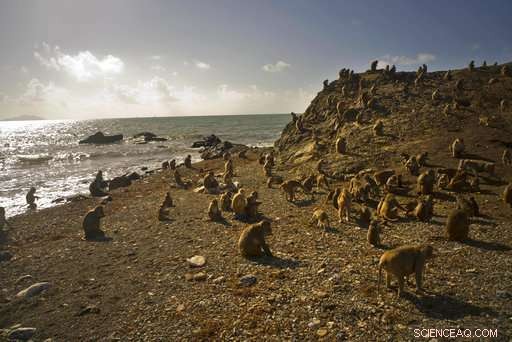
En ce mercredi, 4 octobre photos 2017, les singes se promènent sur Cayo Santiago, connue sous le nom d'île aux singes, à Porto Rico. L'un des premiers endroits où l'ouragan Maria a frappé le territoire américain le 20 septembre a été Monkey Island, un affleurement de 40 acres au large de la côte est qui est l'un des sites les plus importants au monde pour la recherche sur la façon dont les primates pensent, socialiser et évoluer. (Photo AP/Ramon Espinosa)
Alors que des milliers de soldats et de fonctionnaires luttent pour rétablir une vie normale à Porto Rico, un petit groupe de scientifiques fait la course pour sauver plus de 1, 000 singes dont le cerveau peut contenir des indices sur les mystères de l'esprit humain.
L'un des premiers endroits où l'ouragan Maria a frappé le territoire américain le 20 septembre a été Cayo Santiago, connue sous le nom d'île aux singes, un affleurement de 40 acres au large de la côte est qui est l'un des sites les plus importants au monde pour la recherche sur la façon dont les primates pensent, socialiser et évoluer.
La tempête a pratiquement tout détruit sur l'île, le dépouillant de la végétation, détruire les abreuvoirs en métal des singes et écraser les piliers que les travailleurs de l'Université de Porto Rico utilisent pour apporter des sacs de nourriture pour singes, des boulettes brunes d'aliments transformés qui complètent le régime végétal naturel des primates.
"Tous nos outils ont été détruits, " a déclaré Angelina Ruiz Lambides, le directeur de l'installation de Cayo Santiago. "Est-ce que la FEMA couvre cela ? L'assurance de l'université couvre-t-elle cela ? Je ne sais pas."
Incroyablement, pour autant que les scientifiques puissent le dire jusqu'à présent, les singes ont survécu au coup direct de l'ouragan, peut-être en cherchant les hauteurs et en se regroupant à la base des arbres.
Aucun corps n'a été retrouvé et un recensement ne détecte pas un grand nombre de macaques disparus.
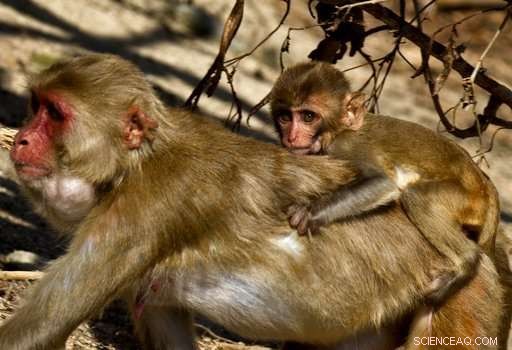
En ce mercredi, 4 octobre photos 2017, une femelle singe porte son bébé sur son dos à Cayo Santiago, connue sous le nom d'île aux singes, à Porto Rico, l'un des sites les plus importants au monde pour la recherche sur la façon dont les primates pensent, socialiser et évoluer. Chaque animal né sur l'île est tatoué pour une identification facile, et le squelette de tous ceux qui sont morts sur neuf générations a été conservé pour référence future. (Photo AP/Ramon Espinosa)
L'histoire de l'île en tant que centre de recherche remonte à 1938, lorsque l'homme connu comme le père de la science américaine des primates a amené une population de macaques rhésus indiens aux États-Unis. Clarence Ray Carpenter voulait un endroit avec le mélange parfait d'isolement et de libre parcours, où les singes pourraient être étudiés vivant comme ils le font dans la nature sans les difficultés de les suivre à travers la nature.
Depuis, les quelque 400 macaques se sont reproduits et multipliés, devenir la population de primates en liberté la plus étudiée au monde et une sorte de bibliothèque vivante.
Chaque animal né sur l'île est tatoué pour une identification facile, et le squelette de tous ceux qui sont morts sur neuf générations a été conservé pour référence future. Environ 100 ont eu leur patrimoine génétique séquencé, et des centaines d'autres ont fait analyser au moins une partie de leur ADN.
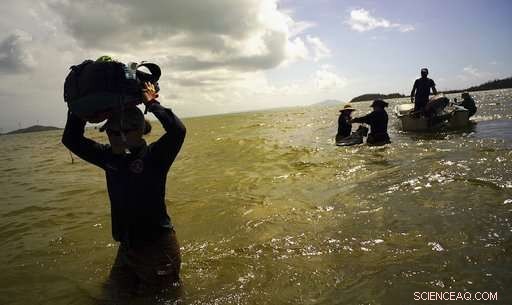
Dans cette capture d'écran réalisée à partir de la vidéo de mercredi, 4 octobre 2017, les scientifiques retournent à terre de Cayo Santiago, connue sous le nom d'île aux singes, à Porto Rico, l'un des sites les plus importants au monde pour la recherche sur la façon dont les primates pensent, socialiser et évoluer. Après le passage de l'ouragan Maria, le personnel de l'université et les employés locaux qui font fonctionner Monkey Island transportent frénétiquement des sacs de nourriture dans un petit esquif, nourrir les macaques avec un régime de survie et essayer de rassembler les collecteurs d'eau de pluie et les abreuvoirs qui maintiennent les animaux en vie sous le soleil tropical. (Photo AP/Ramon Espinosa)
Des chercheurs de Yale, l'Université de Pennsylvanie, L'Université de New York et d'autres ont passé une grande partie de l'année sur l'île à tout étudier, des mouvements oculaires des singes aux gènes et au comportement d'individus socialement aberrants qui peuvent donner un aperçu des causes de l'autisme.
"C'est complètement sans précédent par son ampleur et sa taille, " dit James Higham, un professeur d'anthropologie biologique à NYU qui étudie le comportement des singes, cognition et communication.
Now the university staff and local employees who keep Monkey Island running are frantically ferrying bags of chow in a tiny skiff, feeding the macaques a survival diet and trying to reassemble the rainwater collectors and drinking troughs that keep the animals alive in the tropical sun.
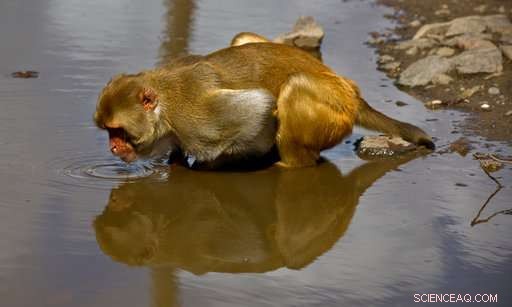
In this Wednesday, Oct. 4, photos 2017, a monkey drinks from a puddle on Cayo Santiago, known as Monkey Island, in Puerto Rico, one of the world's most important sites for research into how primates think, socialize and evolve. Researchers have been spending much of the year on the island studying everything from the monkeys' eye movements to the genes and behavior of socially aberrant individuals that may provide insight into the causes of autism. (AP Photo/Ramon Espinosa)
Mainland scientists are bringing in equipment from chain saws to a portable pier, funded by tens of thousands of dollars raised so far in university departments and online.
Complicating the effort, the monkeys all carry herpes B, a version of the virus that is harmless to macaques but can be fatal in humans. Anyone who comes into contact with monkey saliva or urine must undergo rigorous decontamination and treatment with antiretroviral drugs.
Humans also pose risks for the monkeys. Because the hurricane destroyed the island's chemical toilet, researchers and workers can stay only until they need a bathroom break:Human waste could start an epidemic that could wipe out the monkeys.
While the rescue effort is heroic, "it's not sustainable, " said Higham, who is bringing in a container full of supplies, possibly on a ship that would anchor off the island. "They're doing the best they can do under very difficult conditions, but it needs help and attention."
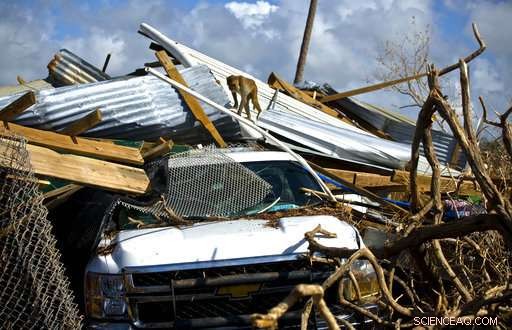
In this Wednesday, Oct. 4, photos 2017, a monkey walks over the rubble left in the wake of Hurricane Maria on Cayo Santiago, known as Monkey Island, in Puerto Rico, one of the world's most important sites for research into how primates think, socialize and evolve. The storm destroyed virtually everything on the island, stripping it of vegetation, wrecking the monkeys' metal drinking troughs and crushing the piers that University of Puerto Rico workers use to bring in bags of monkey chow, brown pellets of processed food that complete the primates' natural vegetation diet. (AP Photo/Ramon Espinosa)
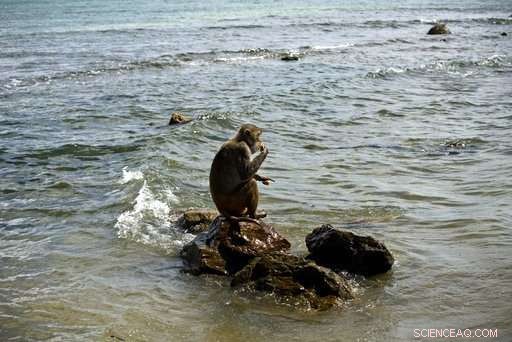
In this Wednesday, Oct. 4, photos 2017, a monkey eats atop a rock off of Cayo Santiago, known as Monkey Island, in Puerto Rico, one of the world's most important sites for research into how primates think, socialize and evolve. The island's history as a research center dates to 1938, when the man known as the father of American primate science brought a population of Indian rhesus macaques to the United States. (AP Photo/Ramon Espinosa)
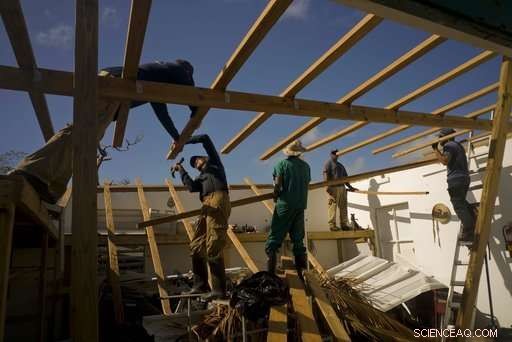
In this Wednesday, Oct. 4, photos 2017, workers repair research facilities destroyed by Hurricane Maria in Cayo Santiago, known as Monkey Island, in Puerto Rico, one of the world's most important sites for research into how primates think, socialize and evolve. Mainland scientists are bringing in equipment from chain saws to a portable pier, funded by tens of thousands of dollars raised so far in university departments and online. (AP Photo/Ramon Espinosa)
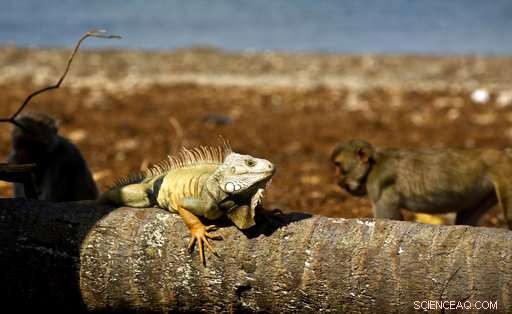
In this Wednesday, Oct. 4, photos 2017, an iguana sunbathes as monkeys walk behind on Cayo Santiago, known as Monkey Island, in Puerto Rico, one of the world's most important sites for research into how primates think, socialize and evolve. In 1938, man known as the father of American primate science, Clarence Ray Carpenter, wanted a place with the perfect mix of isolation and free range, where the monkeys could be studied living much as they do in nature without the difficulties of tracking them through the wild. (AP Photo/Ramon Espinosa)
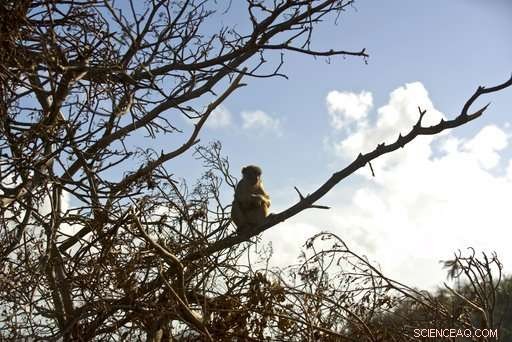
In this Wednesday, Oct. 4, photos 2017, a monkey rests on a tree branch on Cayo Santiago, known as Monkey Island, in Puerto Rico, one of the world's most important sites for research into how primates think, socialize and evolve. Since 1938, the 400 or so macaques have reproduced and expanded their numbers, becoming the world's most studied free-ranging primate population and something of a living library. (AP Photo/Ramon Espinosa)
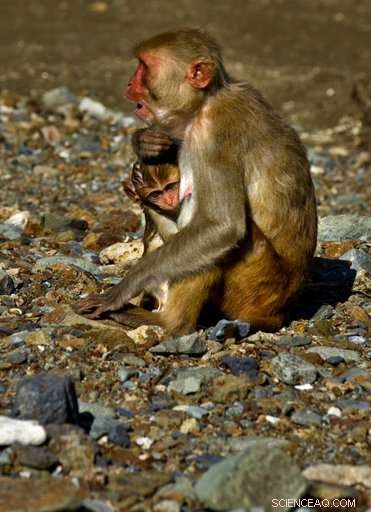
In this Wednesday, Oct. 4, photos 2017, a female monkey holds her baby on Cayo Santiago, known as Monkey Island, in Puerto Rico, one of the world's most important sites for research into how primates think, socialize and evolve. Every animal born on the island is tattooed for easy identification, and the skeleton of every one that has died over nine generations has been saved for future reference. (AP Photo/Ramon Espinosa)
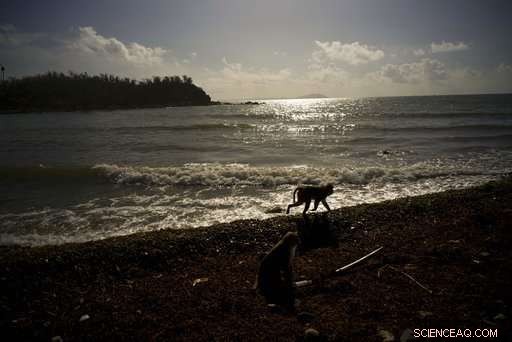
In this Wednesday, Oct. 4, photos 2017, a monkey walks along the shore of Cayo Santiago, known as Monkey Island, in Puerto Rico, one of the world's most important sites for research into how primates think, socialize and evolve. About 100 macaque monkeys here have had their entire genetic makeup sequenced, and hundreds more have had at least some of their DNA analyzed. (AP Photo/Ramon Espinosa)
© 2017 La Presse Associée. Tous les droits sont réservés.